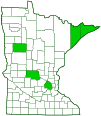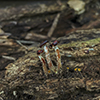honey mushroom
(Armillaria sinapina)
Conservation • Description • Habitat • Ecology • Distribution • Taxonomy
Conservation Status |
|
|||||||
| IUCN Red List | not listed |
|||||||
| NatureServe | not listed |
|||||||
| Minnesota | not listed |
|||||||
Description |
||
Armillaria sinapina is an uncommon, wood-rotting, gilled mushroom. It occurs in Europe and North America. In the United States it occurs in the east from Maine to South Carolina, west to Minnesota and eastern Texas. In the west it occurs west of the Rocky Mountains from northern Washington to central California. In the east it is found mostly on hardwoods, occasionally on conifers. In the Pacific Northwest it is more common on conifers. It appears in September and October, singly or in groups of two to five. It grows on dead stumps, on live trees, and on the ground attached to underground roots. It obtains its nutrients from dead wood (saprobic) and from living wood and tree roots (parasitic). It causes both white wood rot and Armillaria root rot disease, which ultimately kills the tree. Armillaria sinapina is an uncommon, wood-rotting, gilled mushroom. It occurs in Europe and North America. In the United States it occurs in the east from Maine to South Carolina, west to Minnesota and eastern Texas. In the west it occurs west of the Rocky Mountains from northern Washington to central California. In the east it is found mostly on hardwoods, occasionally on conifers. In the Pacific Northwest it is more common on conifers. It appears in September and October, singly or in groups of two to five. It grows on dead stumps, on live trees, and on the ground attached to underground roots. It obtains its nutrients from dead wood (saprobic) and from living wood and tree roots (parasitic). It causes both white wood rot and Armillaria root rot disease, which ultimately kills the tree. When it first appears, the fruiting body is entirely enveloped in a golden yellow, egg-like, protective covering (universal veil). When young, the cap is convex. The overall color is grayish-orange or cinnamon-brown, sometimes with very dark shades of what has been imaginatively described as “Venetian red”, “eye-brown”, or “chestnut”. The upper surface is dry and is covered with dark brown or “tile red” tufts of hairs and fibers (fibrils). It is sometimes densely covered with small scales. Remnants of the universal veil remain as golden yellow, sometimes wart-like, tufts of fibrils. As it ages the cap expands, becoming broadly convex above and flat below. Mature caps are ¾″ to 2⅜″ (2 to 6 cm) in diameter. The margins are lined. Shreds of white tissue, remnants of the partial veil, hang from the margin. The gills are white, thick, closely spaced, and forked. They are broadly attached to the stalk and slightly or strongly run down the stalk (decurrent). As they age they turn cream colored to cinnamon colored. Between the main gills there are short gills that do not extend to the stalk. The stalk is cream colored, 1½″ to 3″ (4 to 8 cm) long, and 3⁄16″ to ⅜″ (5 to 10 mm) thick. It is covered with grayish-brown to brick red fibers. When young, there is a very thin and delicate ring of tissue, the remains of the partial veil, on the upper part of the stalk. The ring eventually collapses and adheres to the stalk. The lower part of the stalk is partially or sometimes completely covered with golden yellow remnants of the universal veil. The stalk sometimes turns brown where bruised. The flesh is white to cream colored. The spore print is ivory. The underground vegetative portion (mycelium) is bioluminescent but the fruiting body (mushroom) is not. The purpose of the bioluminescence may be to attract insects that will disperse the spores, or to deter insects and animals that may eat it. It could also be a byproduct of other biochemical functions and have no other purpose. |
||
Similar Species |
||
Habitat and Hosts |
||
Hardwoods and conifers |
||
Ecology |
||
Season |
||
Early September to early October |
||
Distribution |
||||
|
Sources |
|||
| 12/20/2022 | ||||
Occurrence |
||||
Uncommon |
||||
Taxonomy |
|||
| Kingdom | Fungi (Fungi) | ||
| Subkingdom | Dikarya | ||
| Phylum | Basidiomycota (Basidiomycete Fungi) | ||
| Subphylum | Agaricomycotina (Higher Basidiomycetes) | ||
| Class | Agaricomycetes (Mushrooms, Bracket Fungi, Puffballs, and Allies) | ||
| Subclass | Agaricomycetidae | ||
| Order | Agaricales (Common Gilled Mushrooms and Allies) | ||
| Suborder | Marasmiineae | ||
| Family | Physalacriaceae | ||
| Genus | Armillaria (honey mushrooms) | ||
Armillaria sinapina was first described in 1987. It is one of nine North American species that are similar in appearance and difficult to distinguish. They are often treated together as the cryptic species complex Armillaria mellea group. Five or six of them occur in Minnesota. |
|||
Synonyms |
|||
|
|||
Common Names |
|||
This species has no common name. The common name of the genus Armillaria is honey mushrooms, and it is applied here for convenience. |
|||
Glossary
Parasitic
Obtaining nutrients from another living organism.
Partial veil
A protective covering over the gills or pores of a developing mushroom. At maturity it disappears, collapses into a ring around the stalk, or wears away into a cobwebby covering and ring zone.
Saprobic
A term often used for saprotrophic fungi. Referring to fungi that obtain their nutrients from decayed organic matter.
Universal veil
An egg-like structure that envelopes all or most of a developing gill mushroom. Remnants of the universal veil sometimes visible on a mature mushroom are patchy warts on the cap, a ring on the stalk, and a volva at the base of the stalk.
Visitor Photos |
|||||
Share your photo of this fungus. |
|||||
| This button not working for you? Simply email us at info@MinnesotaSeasons.com. Attach one or more photos and, if you like, a caption. |
|||||
Honey Fae (Farah) |
|||||
Bioluminescent species in daylight |
|||||
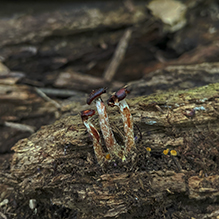 |
|||||
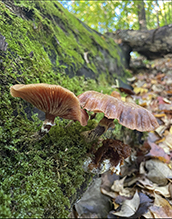 |
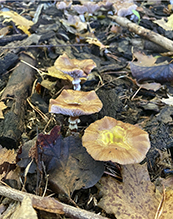 |
||||
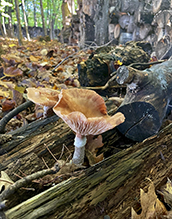 |
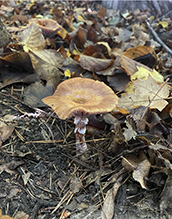 |
||||
MinnesotaSeasons.com Photos |
|||||
|
|||||

Slideshows |
||

Visitor Videos |
|||
Share your video of this fungus. |
|||
| This button not working for you? Simply email us at info@MinnesotaSeasons.com. Attach a video, a YouTube link, or a cloud storage link. |
|||
Other Videos |
|||
| Опёнок горчичный (Armillaria sinapina) Гриби України |
|||
About
Oct 31, 2016 Подписывайтесь на нашу группу "Гриби України" в Facebook: --- Грибники привет! В этом ролике я расскажу вам про настоящий Опёнок осенний, но с небольшой поправкой, осенний опёнок в широком понимании – это не один вид, а можно сказать собирательный образ объединяющий в себе целый комплекс видов. В мире род Armillaria насчитывает около 40, а у нас около 10 различных видов. Большинству грибников это не интересно, но продвинутые из них обращают внимание, что опята растущие в наших лесах отличаются друг от друга – одни могут быть темнее других, или наоборот светлее, вплоть до ярко жёлтых, одни с ровными ножками, а другие со вздутыми, а третьи и вовсе без привычной плёнки/кольца под шляпкой. Так вот, сейчас в кадре находится не обычный Опёнок осенний в понимании вида, а родственный ему Опёнок горчичный (Armillaria sinapina). Все настоящие опята являются паразитами, т.е. селятся на живых деревьях, но они так же могут существовать и как сапротрофы, т.е. расти на мёртвой древесине – опята частые обитатели вырубок. Опята наверно самые всеядные грибы нашей зоны – встретить их можно практически на всех древесных и кустарниковых растениях, но всё таки они предпочитают лиственные леса, так же они изредка селятся на травянистых растениях, например в зарослях крапивы. Растут опята с конца августа до начала зимы, большими семьями, в благоприятные годы очень массово, настолько, что с одного пня, или бревна можно собрать целую корзину. А теперь всё таки поговорим об Опёнке горчичном – чем же он отличается от опёнка осеннего, - да собственно кардинальное отличие только одно. Это яркий, жёлтый, или жёлто-зелёный цвет ножек и покрывала, и оливково-жёлто-коричневая шляпка, в остальном это классический опёнок осенний – те же шляпки, покрытые чешуйками, плёнчато-паутинистое покрывало под шляпкой, позже от него на ножке остаётся кольцо и толстые ножки у молодых экземпляров. Опёнок горчичный имеет сходство с Опёнком медовым, который так же входит в группу осенних опят. Настоящие опята относят как съедобным, так и к условно-съедобным грибам, на западе он вообще не ценится, впрочем на его популярности у нас этот факт не сказывается ))) У нас это популярный и всеми любимый гриб. Однако нужно знать, что в сыром виде этот гриб ядовит! Так как содержит нестабильные токсины, разрушающиеся во время кулинарной обработки. Google Translate: Mushrooms hello! In this video, I will tell you about the real Autumn honey agaric, but with a slight correction, the autumn honey agaric in the broadest sense is not one species, but one can say a collective image that combines a whole complex of species. In the world, the genus Armillaria has about 40, and we have about 10 different species. Most mushroom pickers are not interested in this, but the advanced ones pay attention to the fact that mushrooms growing in our forests differ from each other - some may be darker than others, or vice versa lighter, up to bright yellow, some with even legs, and others with swollen, and and still others without the usual film / ring under the hat. So, now in the frame there is not an ordinary autumn honey agaric in the understanding of the species, but a related mustard honey agaric (Armillaria sinapina). All real mushrooms are parasites, i.e. settle on living trees, but they can also exist as saprotrophs, i.e. grow on dead wood - honey mushrooms are frequent inhabitants of clearings. Honey mushrooms are probably the most omnivorous mushrooms in our zone - they can be found on almost all woody and shrubby plants, but still they prefer deciduous forests, they also occasionally settle on herbaceous plants, for example, in nettle thickets. Mushrooms grow from the end of August to the beginning of winter, in large families, in favorable years, very massively, so much so that a whole basket can be collected from one stump or log. And now we’ll still talk about the mustard honey agaric - how does it differ from the autumn honey agaric - but actually there is only one cardinal difference. This is a bright, yellow, or yellow-green color of the legs and bedspreads, and an olive-yellow-brown hat, otherwise it is a classic autumn honey agaric - the same hats covered with scales, a membranous cobweb cover under the hat, later a ring remains on the leg and thick legs in young specimens. Mustard honey agaric is similar to honey agaric, which is also included in the group of autumn mushrooms. Real mushrooms are classified as both edible and conditionally edible mushrooms, in the West it is not valued at all, however, this fact does not affect its popularity with us))) It is a popular and beloved mushroom for us. However, you need to know that this mushroom is poisonous in its raw form! Since it contains unstable toxins that are destroyed during cooking. |
|||

Visitor Sightings |
|||||
Report a sighting of this fungus. |
|||||
| This button not working for you? Simply email us at info@MinnesotaSeasons.com. Be sure to include a location. |
|||||
| Honey Fae (Farah) 9/24/2022 |
Location: Hennepin County, MN Bioluminescent species in daylight |
||||
| Honey Fae (Farah) October 2021 |
Location: Hennepin County |
||||
MinnesotaSeasons.com Sightings |
|||||
|
|||||

Created: 12/20/2022
Last Updated:
